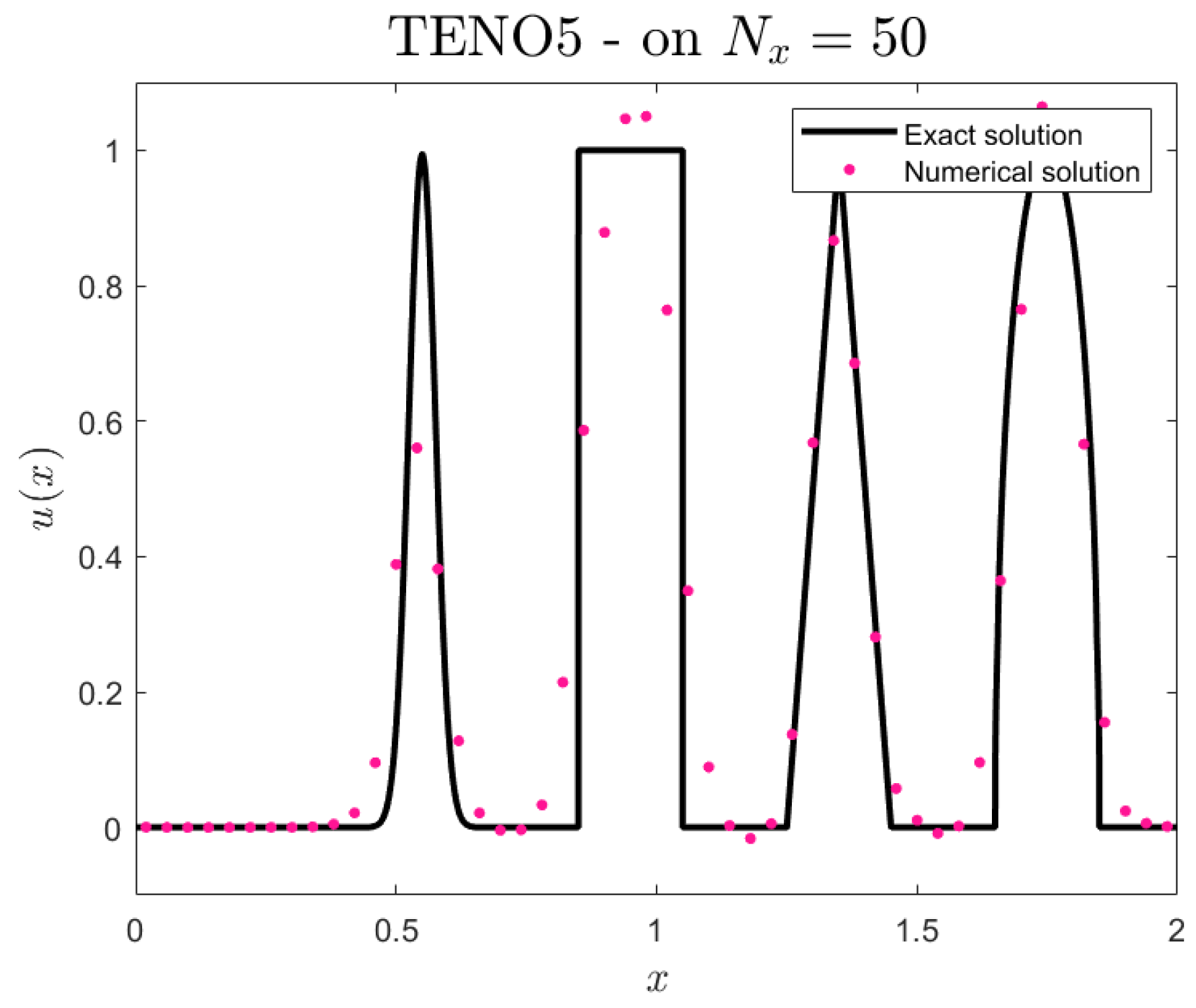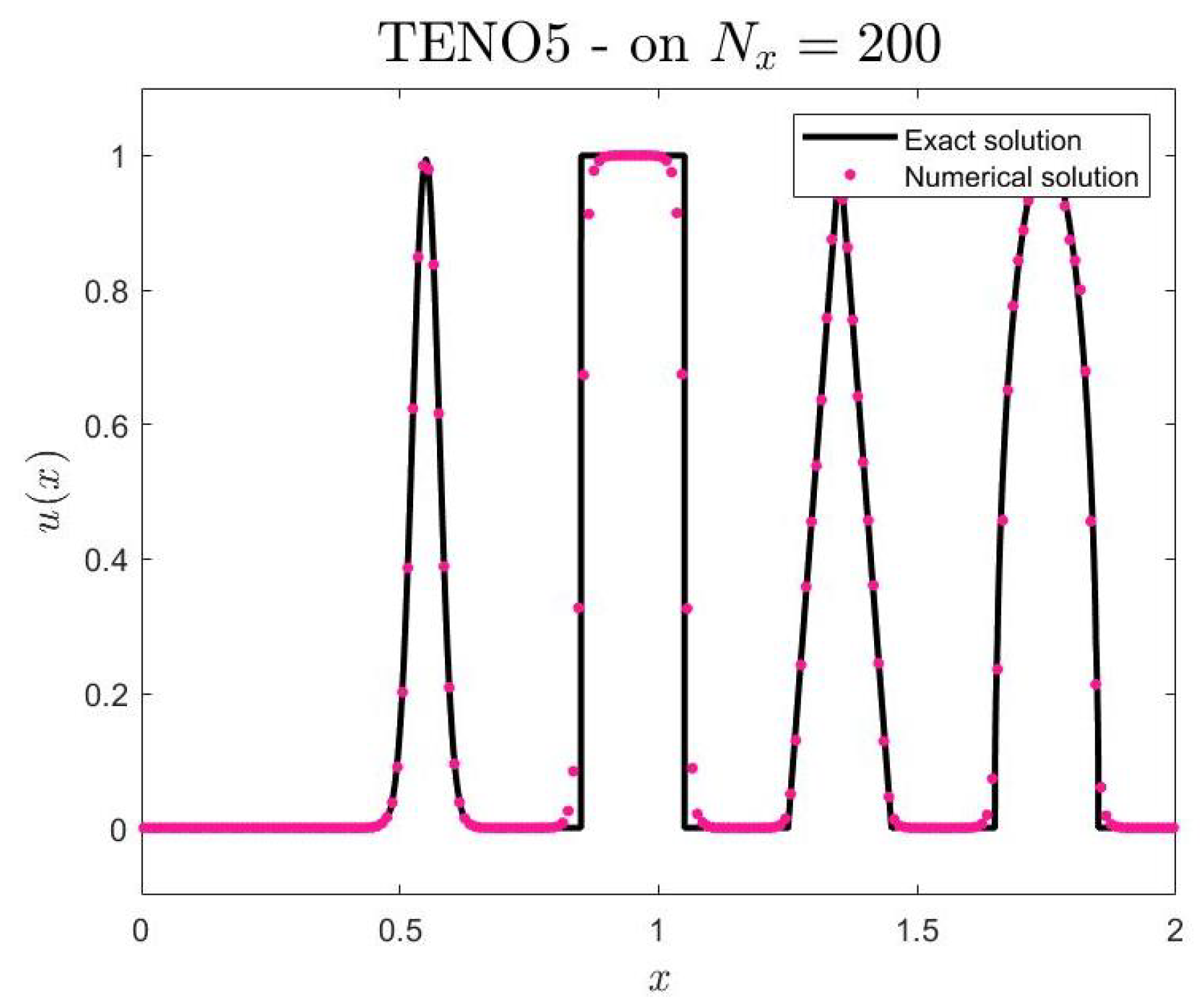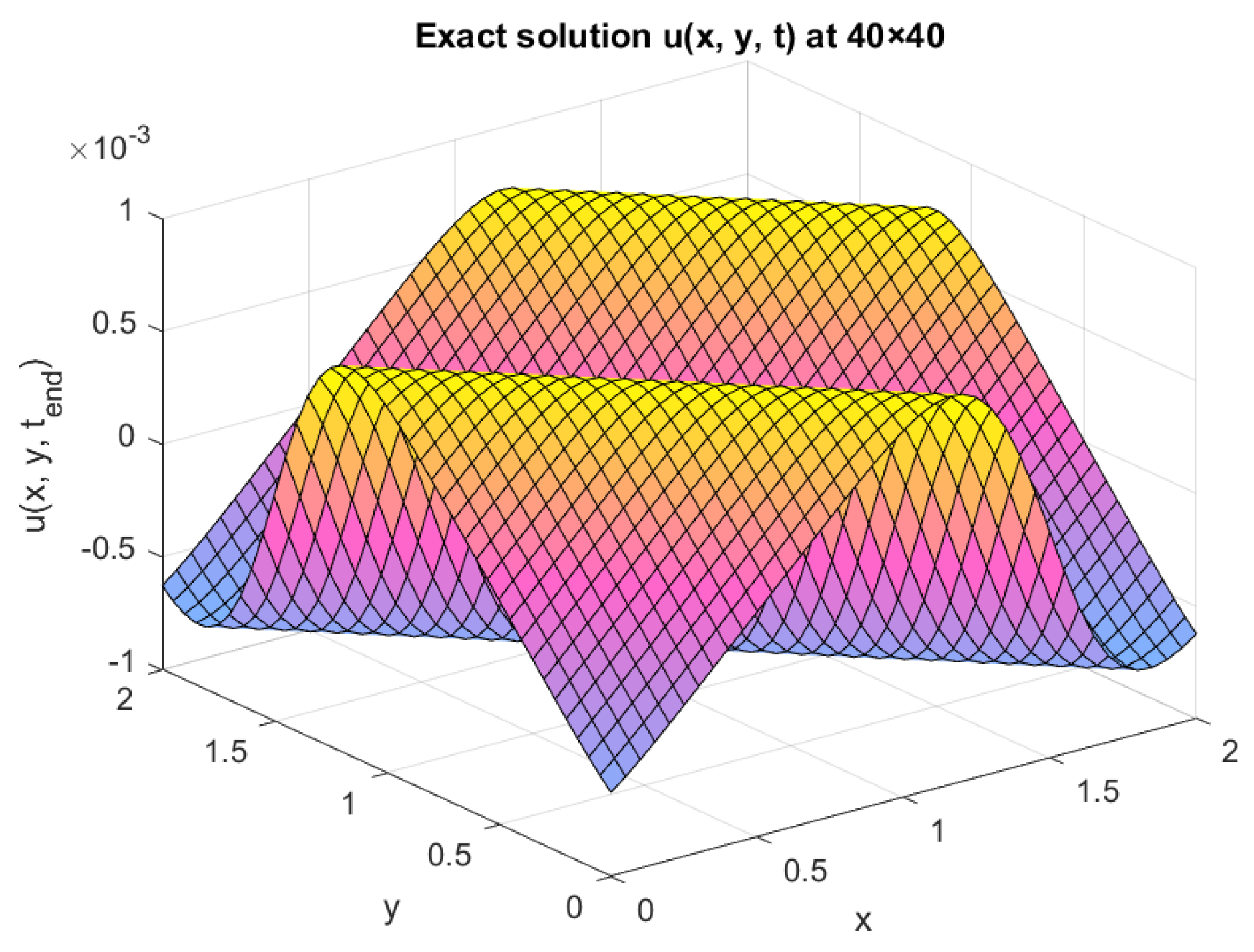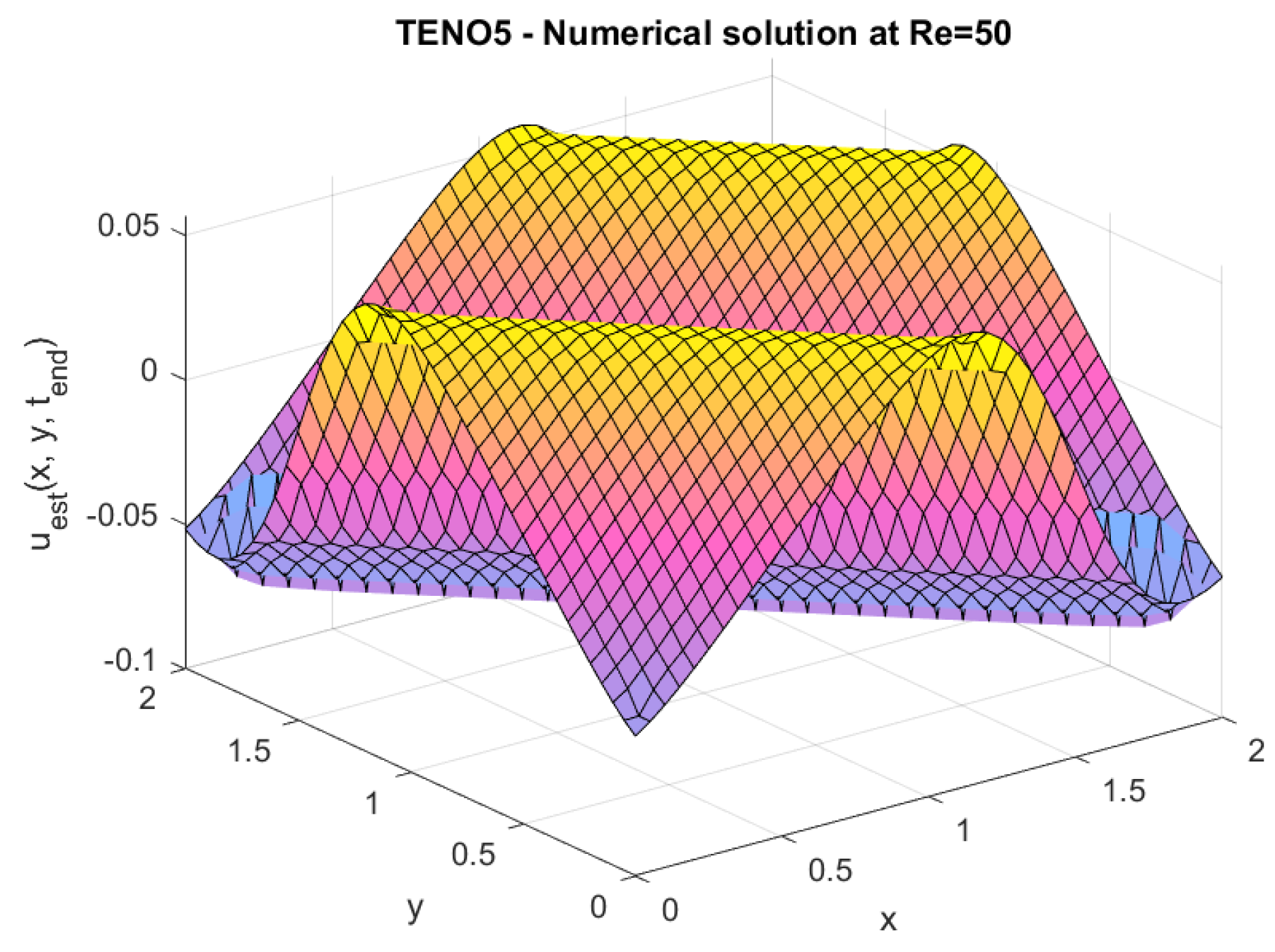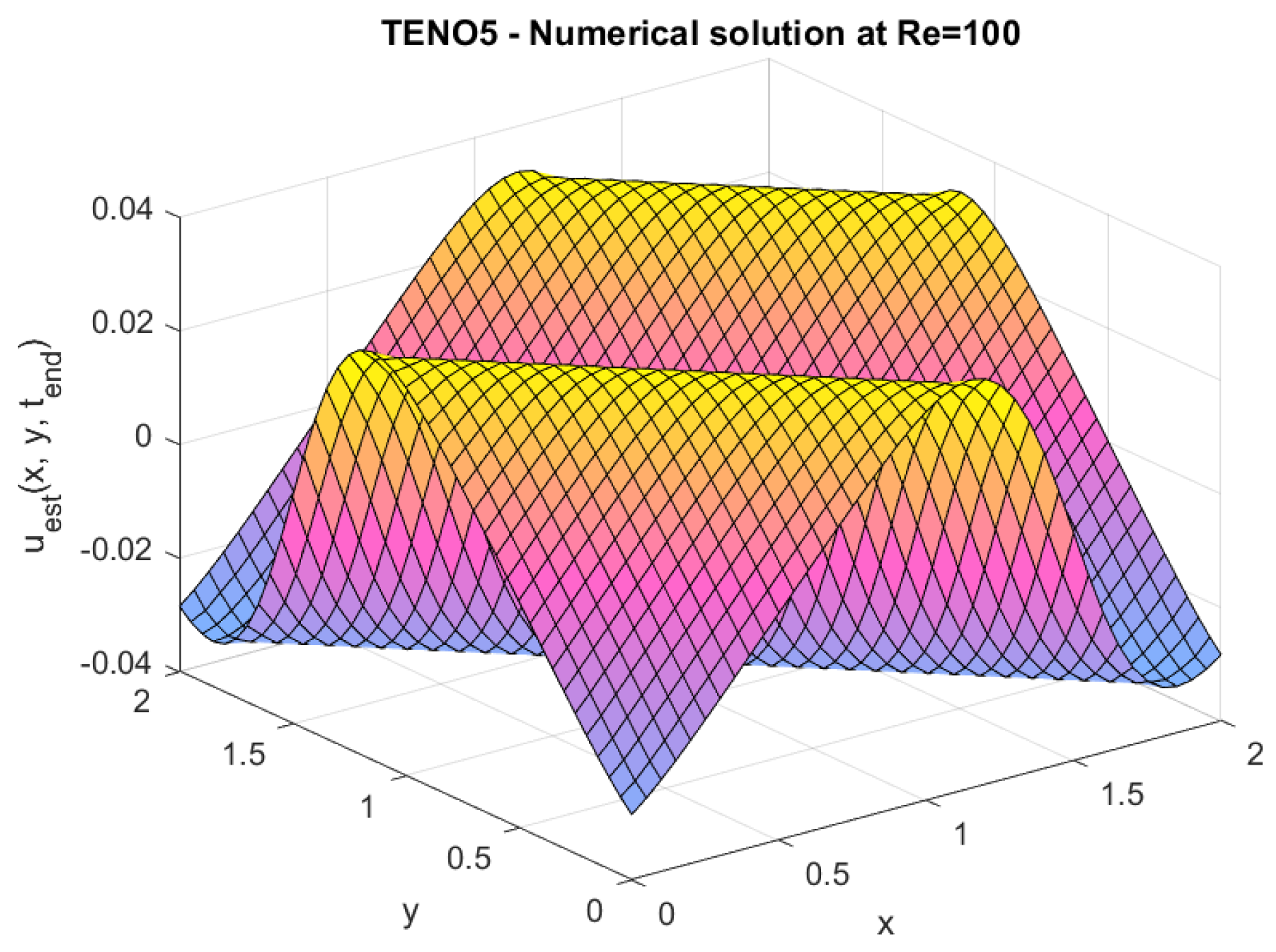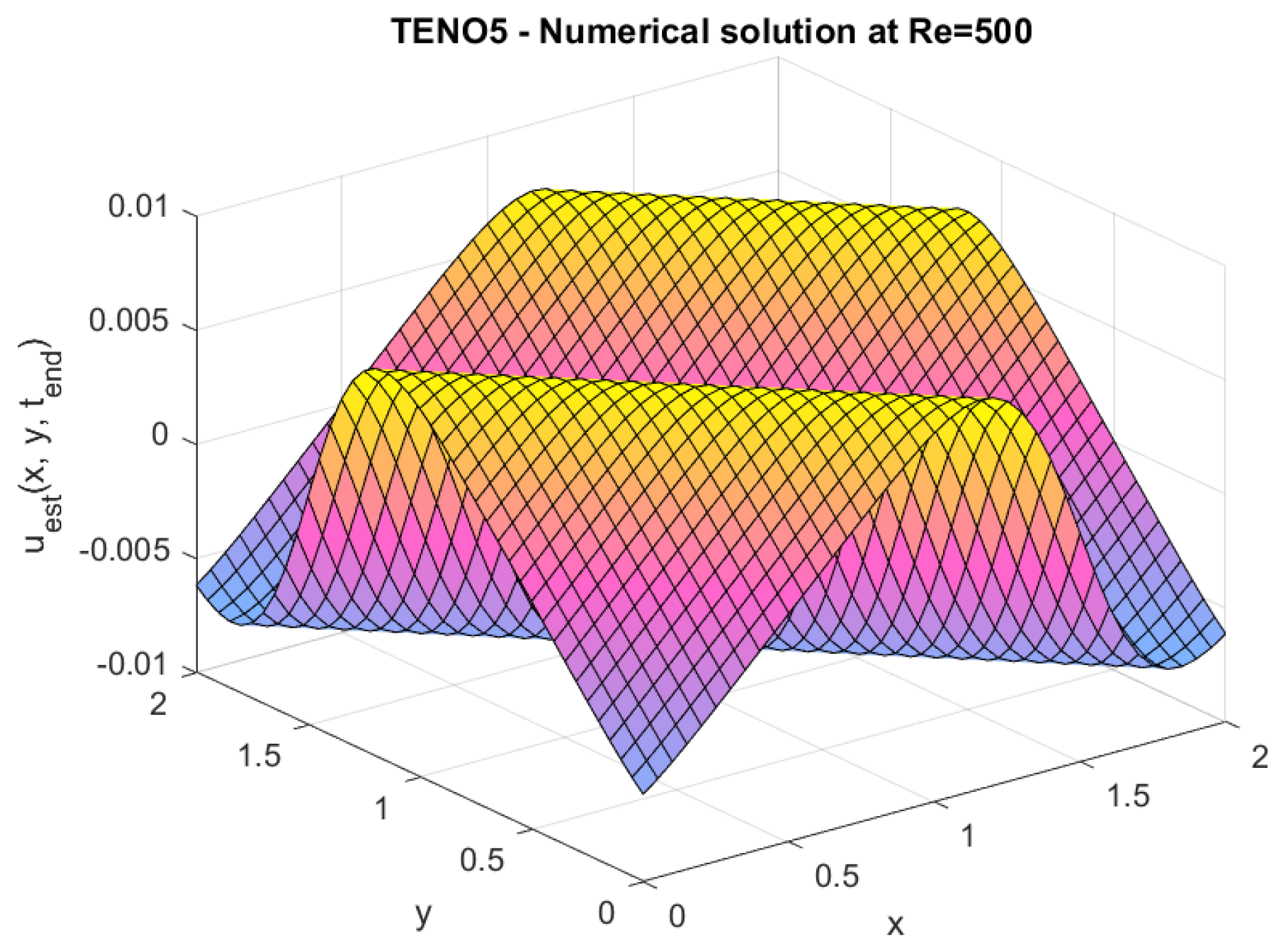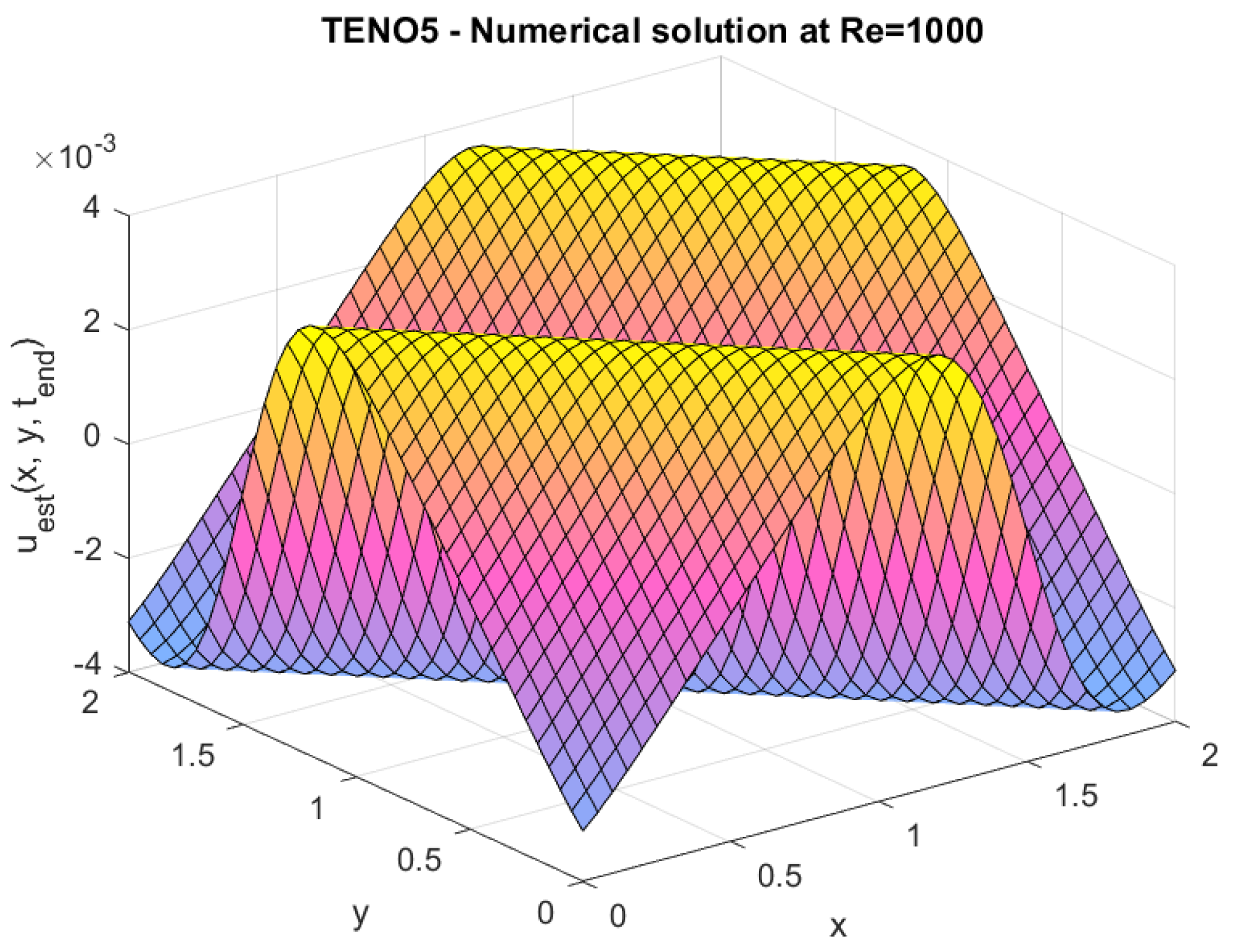1. Introduction
Computational fluid dynamics (CFD) refers to the numerical analysis of systems involving fluid motion, heat transfer, and related phenomena, such as chemical reactions, through computer simulations. This computational approach is widely applied across both industrial and non-industrial sectors.
CFD techniques play a crucial role in various industries, such as the design, research, development, and production of aircraft and jet engines. Furthermore, CFD has found extensive application across an array of other industries, demonstrating its wide-ranging impact and utility [
1,
2].
The finite volume method (FVM) is a numerical technique developed to solve partial differential equations (PDEs) that encapsulate various conservation laws, including those related to mass, momentum, and energy. By integrating these equations over well-defined control volumes, the FVM effectively transforms them into a system of algebraic equations. This transformation is crucial as it inherently preserves local conservation properties, ensuring that fundamental physical principles are maintained. Over the years, the finite volume method has undergone significant evolution, adapting to tackle increasingly complex challenges within the field of computational fluid dynamics (CFD). Its versatility and robustness render it a recommended choice for simulating fluid flow across a wide range of applications, from aerospace engineering to environmental modeling [
1,
2,
3,
4].
The FVM framework includes several essential computational steps. Initially, a mesh is generated to partition the computational domain into small, discrete control volumes that can be analyzed independently. Next, the evaluation of flux across the boundaries of these control volumes is performed, which involves calculating conserved quantities such as fluid velocity and pressure. Finally, appropriate boundary conditions are applied to define the behavior of the fluid at the edges of the computational domain. By carefully following these steps, the finite volume method provides an effective and reliable framework for simulating complex phenomena in fluid dynamics [
1,
2,
3].
There have been several studies using numerical methods presented in the literature for solving nonlinear partial differential equations (PDEs). Recent studies have been proposed based on physics-informed neural networks (PINNs) and finite difference methods (FDMs), and they have shown promising performances for modeling complex waves and nonlinear dynamics, such as Burgers’ and sine-Gordon equations [
5,
6]. Although these techniques provide valuable insights, this work chooses the finite volume method (FVM) framework due to its conservative implementation and robustness concerning sharp gradients and discontinuities, which are important when dealing with high-resolution schemes like TENO5.
The finite volume method (FVM) has been applied by researchers to address a variety of problems in computational fluid dynamics. The FVM is effective in solving the Poisson equation, heat equation, and diffusion equation, which govern numerous physical processes [
7,
8]. Additionally, its application with unstructured moving meshes for simulations highlights its capability to manage free surface flows [
9].
In the finite volume method (FVM), various numerical schemes have unique characteristics, such as conservativeness, boundedness, and transportiveness. This research utilizes a high-order method, specifically the fifth-order targeted essentially non-oscillatory (TENO5) scheme, which aims to improve both numerical stability and accuracy.
The primary aim of this paper is to explore the fifth-order targeted essentially non-oscillatory (TENO5) scheme within the finite volume method for addressing a one-dimensional linear advection equation and a two-dimensional nonlinear Burgers’ equation that includes diffusion. The finite volume method will be developed and utilized to tackle these equations, and numerical experiments will be conducted to evaluate the approximate solutions against the exact solutions.
This paper is organized as follows:
Section 2 provides a brief overview of the targeted essentially non-oscillatory (TENO) scheme.
Section 3 presents numerical experiments to evaluate the performance of the TENO scheme.
Section 4 includes a discussion of the results. Finally,
Section 5 concludes the paper and proposes future research directions, particularly focusing on extending the higher-order capabilities of the TENO scheme and exploring its application in 3D numerical experiments.
2. Targeted Essentially Non-Oscillatory (TENO) Scheme
The targeted essentially non-oscillatory (TENO) approach is crafted to minimize oscillations that may arise in the numerical solutions of problems featuring sharp gradients or discontinuities, commonly seen in computational fluid dynamics (CFD) and other areas that require the simulation of wave propagation or transport processes. TENO effectively addresses turbulence while maintaining controllable, low numerical dissipation. In the TENO approach, a scale separation technique adeptly distinguishes between discontinuities and minor fluctuations, leading to reduced dissipation when compared to conventional methods, which can produce oscillations and instabilities in the presence of strong shocks [
10,
11,
12].
This paper will discuss the fifth-order version of the method, known as the fifth-order targeted essentially non-oscillatory (TENO5) scheme.
2.1. TENO Methodology in FVM Framework
The scalar hyperbolic conservation law in one dimension is given by
An equivalent formulation is as follows:
The initial condition is defined as
Discretizing Equation (
1) on uniform cell elements, e.g.,
with
for
, the system reduces to a set of ordinary differential equations (ODEs) of the form
where
expresses the cell-averaged conservative variable in
.
Moreover, Equation (
4) could be approximated as
The numerical fluxes at the cell interface
and
in the semi-discrete finite volume scheme, which is given in Equation (
6), can be computed using a Riemann solver. For example, the flux
is given by
Here, and represent left-biased reconstruction and right-biased reconstruction, respectively, within cell .
Even though the exact Riemann problem can be solved at the cell interface, approximate Riemann solvers are commonly used for their high efficiency. There are many different variants of approximate Riemann solvers, such as the Rusanov flux, the Roe flux, and the HLLC flux, as detailed in [
12,
13]. They can be represented in a general form as follows:
where
denotes the characteristic signal velocity evaluated at the cell interface.
The reconstruction candidate stencils: To achieve high-order reconstruction, a polynomial can be found for each candidate stencil by solving a linear system through Equation (
5) with an approximation that is represented by
where
k indicates the stencil’s width. The coefficient
is determined by solving the system of linear algebraic equations formed by substituting
into Equation (
5) and evaluating the integral functions at the stencil nodes. In terms of the five-point scheme, the reconstructed conservative variable at the cell interface can be obtained as demonstrated in [
10,
11].
Scale separation: To separate smooth scales from discontinuities effectively, the smoothness indicators are defined as follows:
where the parameters are
, and
to avoid a zero denominator, and
K is the number of points.
can be determined using
To obtain a high-order accurate scheme at the critical points, the global reference smoothness indicator
is introduced for the five-point scheme, as presented in [
11].
The TENO scheme is based on the principle of either abandoning the non-smooth stencil or applying the stencil with the optimal linear weights for the final reconstruction. To achieve this, the smoothness indicators are normalized as follows:
Here, the sharp cut-off function is defined by
The cut-off parameter determines the dissipation properties of the resulting scheme, and it is typically set to .
If the large candidate stencil is judged to be smooth, i.e.,
, the final reconstruction
can be directly expressed as
. Otherwise, the final reconstruction is obtained through a nonlinear combination of the remaining small stencils, expressed as
where the weight
is expressed as
Here,
is the optimal weight to achieve the maximum accuracy order with the full stencil [
10,
11,
14].
2.2. Time Discretization for TENO Scheme
After employing the finite volume method (FVM) and discretizing the spatial derivatives using the TENO scheme, the semi-discrete form of the governing equation can be expressed as
where
denotes the operator used for spatial discretization.
For time integration, a third-order strong-stability-preserving (SSP) Runge–Kutta method is utilized:
This explicit Runge–Kutta method provides strong stability characteristics while achieving third-order temporal accuracy [
10,
11,
12].
3. Numerical Experiments
In this section, two numerical experiments will be carried out to solve the linear advection of multiple waves and two-dimensional Burgers’ equation with diffusion for comparison purposes and to verify the results.
3.1. Linear Advection of Multiple Waves
Consider the one-dimensional linear advection equation
with the initial condition
where
The parameters are given as
The initial condition consists of a Gaussian pulse, a square wave, a sharp triangle wave, and a half ellipse arranged from the left to the right in the computational domain .
The exact solution, representing the theoretical solution for the linear advection equation with a constant propagation speed
c, is
where
represents the initial profile of the solution at time
.
The final time for the experiment is
. Spatial discretization is performed at various uniform grid points
of
, with a Courant number of
(
Table 1).
3.2. Burgers’ Equation with Diffusion
Consider the two-dimensional Burgers’ equation with diffusion
on the domain
.
When
, the exact solution is given as
with
, and at the final time,
.
In this context, the diffusion coefficient, denoted as
D, is given by the equation
, where
indicates the Reynolds number. In addition, different grid sizes are considered in this experiment, as represented in
Table 2. The plots in this paper are specifically for a 40 × 40 uniform grid (
Table 3).
This work also incorporates an additional study that investigates the performance of the TENO5 scheme at different Reynolds numbers () to examine its suitability within the FVM framework.
The Reynolds number () is an important dimensionless number in fluid dynamics that determines the relative importance of the inertial to viscous force in the system.
At low , viscous effects outweigh inertial effects, and the flow is smooth, while at high , inertial forces are larger, and the flow becomes turbulent or has sharp gradients.
Numerical simulations, which were aimed at investigating the performance of TENO5 in handling a flow regime and simulating both the sharp and smooth features at different , were made to study its potential. The purpose of these tests was to determine the general operation of the scheme in a wide range of flows and to check the stability and accuracy of the solution in a smooth and complex flow.
The numerical results of these experiments are given below.
5. Conclusions
This research evaluates the TENO5 scheme within a finite volume context for problems dominated by advection. Numerical tests on both linear and nonlinear cases reveal its precision, reliability, and convergence. The TENO5 scheme successfully captures smooth wave patterns in linear advection scenarios while maintaining low dissipation and dispersion errors, even though there are slight oscillations near discontinuities. In the case of the two-dimensional Burgers’ equation with diffusion, it effectively addresses nonlinear dynamics at elevated Reynolds numbers and exhibits consistent convergence with grid refinement.
In summary, the TENO5 scheme demonstrates itself to be a very efficient method for problems driven by advection, striking a balance between numerical dissipation and resolution. Future research could broaden this study to encompass more intricate test cases, such as turbulent flows and multi-dimensional nonlinear systems. Moreover, examining higher-order extensions of the TENO framework could further improve accuracy, especially for issues involving fine-scale structures and turbulence. The extension to three-dimensional settings may provide some valuable insight into the performance and robustness properties of the scheme under increased complexity. However, there are difficulties in increased computational cost and the construction of the stencil in three dimensions.

